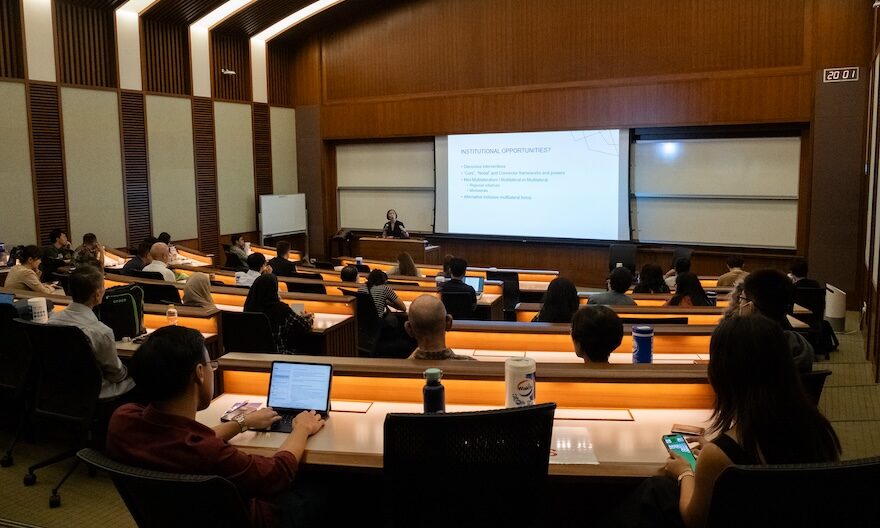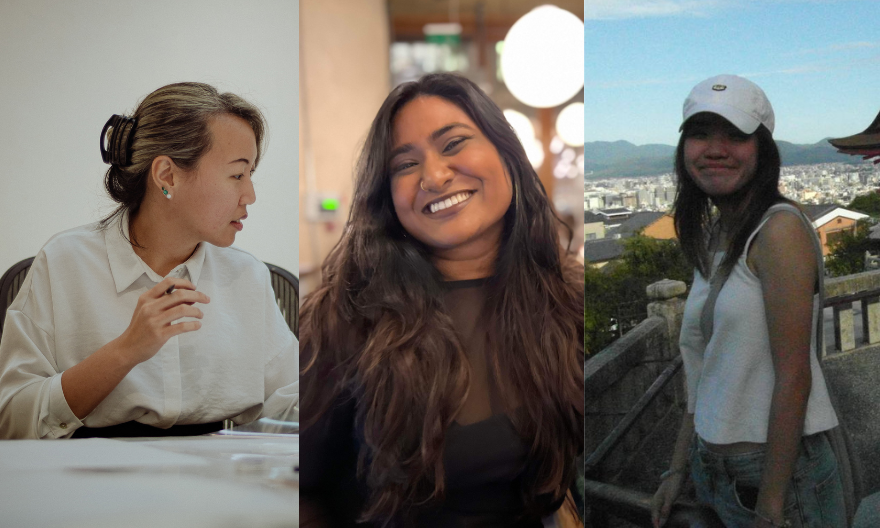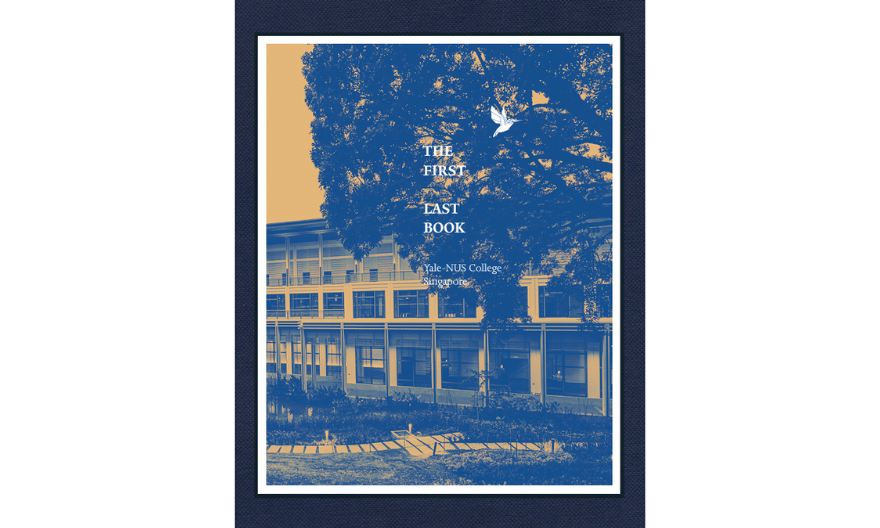Leaving a Lasting Legacy: Yale-NUS Heritage Exhibit
The College’s Heritage Exhibit stands at the intersection of the past, present and future
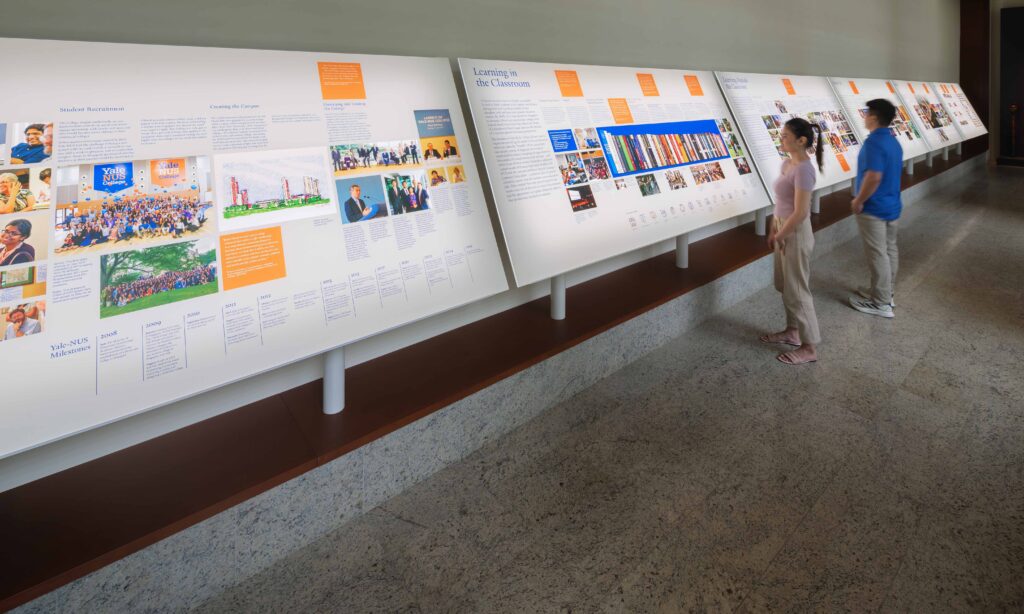
The Yale-NUS Heritage Exhibit is one of the projects the College embarked on to celebrate its legacy. Designed to tell the story of Yale-NUS, its panels highlight innovations in higher education, capture the dynamism, energy, innovation and diversity of the College, and act as a gateway to further exploration.
Situated at the Yale-NUS College Hall Foyer, the Exhibit was designed by Tony Spagnola, Principal at Spagnola & Associates, in collaboration with Vice President, Yale University (retired), Linda Koch Lorimer and Yale-NUS College President and Professor of Social Sciences (Economics) Joanne Roberts.
As the first liberal arts college in Singapore and one of the first in Asia, Yale-NUS has been at the forefront of educational innovation. To honour the College’s legacy, the Yale-NUS Governing Board supported this exhibit, with the aim of preserving its heritage and ensuring that future visitors learn about Singapore’s first foray in establishing a fully residential liberal arts college.
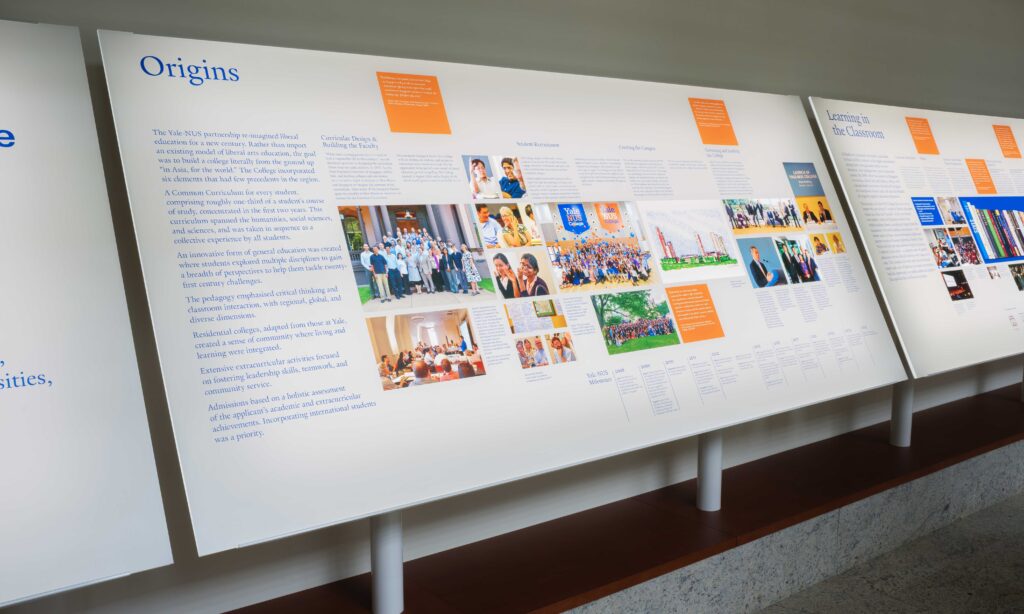
The Heritage Exhibit consists of six panels, also referred to as chapters. As a nod to different aspects that encapsulate the Yale-NUS College experience, the panels are titled ‘Vision’, ‘Origin’, ‘Learning in the Classroom’, ‘Learning Beyond the Classroom’, ‘Student Life’, ‘The Campus’, and ‘Legacy and Gratitude’. Mr Spagnola collaborated with Ms Lorimer and President Roberts to design the panels, incorporating their ideas and ensuring a professional finish. Along with other stakeholders, they painstakingly selected quotes, drafted texts, and organised content that would showcase both the perspectives of the National University of Singapore (NUS) and Yale University, and how Yale-NUS came to form an identity of its own.
“Of course, we had limited space and so there were many more stories and pictures that I wish we could have shared,” said President Roberts of the planning experience, “but I hope that we have captured some of the energy, dynamism, and effervescence of our community.”
On the design concept, Mr Spagnola shared that he wanted the panels to integrate seamlessly into the existing hallway architecture, with a wall and windows opposite that overlook the bio-filtration pond. Each panel is designed with a distinct personality. For example, the ‘Learning in the Classroom’ panel prominently displays a visual array of books from the College’s Common Curriculum, emphasising its global and interdisciplinary approach. By highlighting titles and thinkers studied by students, this panel allows viewers a glimpse into the intellectual diversity of the curriculum.
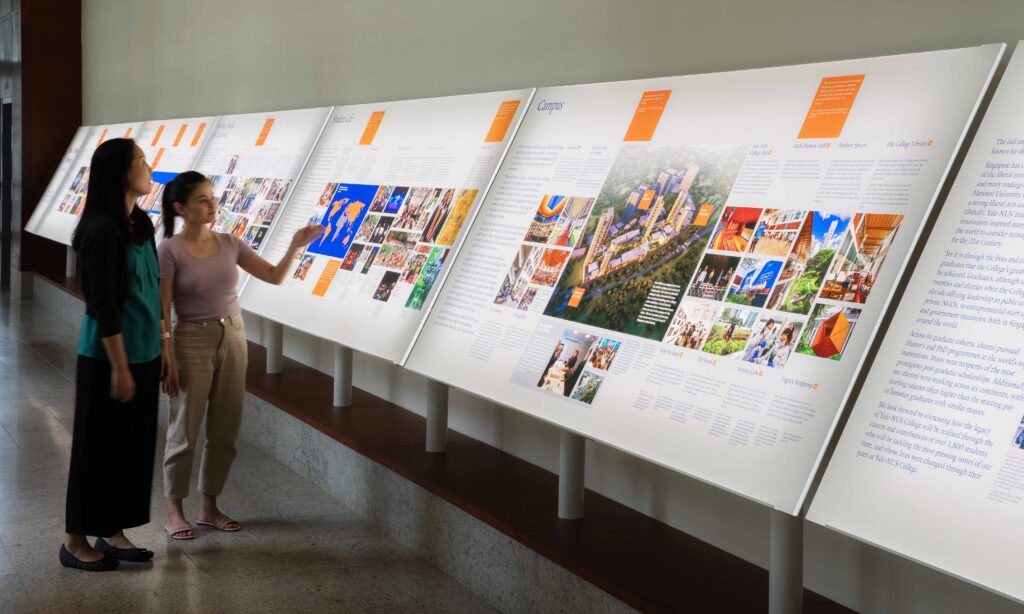
Each panel invites viewers to focus on specific aspects of the College’s story. The ‘Vision’ panel introduces the exhibit and leads into ‘Origin’, which recounts the College’s beginnings as an advisory panel advocating for a liberal arts college in Singapore.
‘Learning in the Classroom’ comes next, with a heavy focus on the College’s curriculum. The College’s Common Curriculum is one of its most unique points, as it was deliberately designed to bring a global perspective by incorporating thinkers from around the world and go beyond Western thinkers that tend to dominate academia.
The ‘Learning Beyond the Classroom’ panel highlights the College’s dynamic learning environment, which provides students with on-campus, off-campus, and overseas initiatives like Week Seven learning experiences, Learning Across Boundaries programmes, and Summer Scholarship opportunities.
No school is complete without its community. The ‘Student Life’ panel is about the very students who passed through the campus, and their journey of learning and growing. Ms Lorimer highlighted the role of faculty and students as “co-makers” of Yale-NUS College; “the faculty’s role in creating the curriculum and fostering the special learning environment was essential as were the contributions of the students which ranged from establishing innovative student organisations to enlivening the residential colleges. We tried to capture this in the design of the heritage exhibition.”
The ‘Campus’ panel explores the physical space that the school occupies. Since Yale-NUS College was an entirely new university at the time of its inception, the College’s architects did not have to work around existing buildings and could instead design every aspect of the College with profound intentionality. Although the College will close in 2025, the space it leaves behind will continue to exist, and people will be able to understand the intention behind architectural choices, such as the integration of faculty offices with classrooms and residential spaces or the placement of the Blackbox Theatre in the centre of the school.
The final panel returns to the idea of students and impact, and is called ‘Legacy and Gratitude’. “It was a remarkable achievement to create – in less than two decades— one of the world’s greatest liberal arts colleges,” Ms Lorimer said. “We hope this exhibition signals some of the reasons why.” When Ms Lorimer was asked who she wished could see the Exhibition, she immediately said, “[Founding prime minister of Singapore] Lee Kuan Yew – since he would have appreciated how the College’s contributed to Singapore’s educational strategy of excellence—and I am curious to ask if he would have liked the College to continue.”
The legacy of Yale-NUS College will continue to be preserved through the impactful innovations adopted and adapted in the liberal arts curriculum and specific NUS courses. Beyond that, the curriculum, and the buildings, and the graduates of the College are the College’s crowning glory. This is why President Roberts cited the ‘Student Life’ panel as her favourite, saying, “It reminds me that the College was always built for our students, and although we are closing, we have had the privilege of having so many creative, innovative, risk-taking, thoughtful, brilliant people pass through our doors. It reminds me that the story of our impact is not over.”
If she could, President Roberts said she would like to look at the exhibit for the first time with the late Associate Professor of Social Sciences (Anthropology), Professor Bernard Bate and the late Professor of Science (Mathematics) Professor Florin Diacu, who passed away in 2016 and 2018 respectively. “I’d invite Barney and Florin, two of our former faculty members who have since passed away, to see it. I love the idea of sharing with them a piece of what they played such an important part in building.”
This tribute to the College is but a herald of things to come. As Yale-NUS College’s students fly the nest, those behind the Heritage Exhibit are excited to see what Kingfishers will continue to accomplish in the decades ahead as they grow and spread their wings, both in Singapore and around the world.

